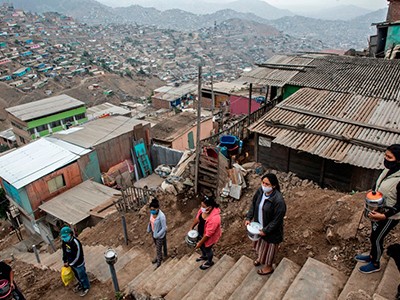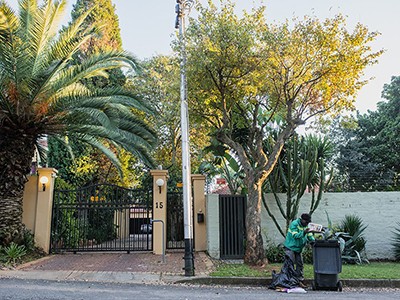
Alexandra township in Johannesburg is next to Sandton, one of South Africa’s wealthiest neighbourhoods.Credit: Chip Somodevilla/Getty
More than two decades ago, researchers began using rigorous experiments to test policies designed to improve the lives of some of the world’s poorest citizens. The movement grew, and randomized controlled trials (RCTs), once reserved for drugs and other health interventions, are now part of the mainstream in the research community that studies global development.
The knowledge resulting from RCTs of all kinds has helped people across the world. It has led to better drugs and new health interventions, as well as educational opportunities, improved agricultural technologies and effective programmes to distribute desperately needed cash. But these benefits have not necessarily flowed equitably, or helped those who need it the most.
How COVID has deepened inequality — in six stark graphics
The pernicious and pervasive effects of inequality in all its forms are all too clear, as Nature reports this week. A special collection of articles includes content that looks at the ways in which COVID-19 has deepened inequality; factors that contribute to gender inequality in science; and an analysis of interventions designed to alleviate poverty.
Researchers are working to understand and measure the root causes, as well as the symptoms, of social inequities. At the same time, like so many others, they are also confronting their own role in a complicated socio-economic system in which benefits such as wealth and opportunity too often flow to those who already experience such advantages.
One of the first things that researchers can do is to ensure that their work is not contributing to outstanding social inequities. Sadly, all too often, the benefits of public-health research are distributed inequitably. Health interventions ranging from COVID-19 vaccines or drugs to new technologies can improve overall public health, but if they reach people in rich countries, or people who already have access to high-quality health care, before those who have fewer advantages, they will also contribute to inequality.
Furthermore, even when the interventions being tested aim to relieve poverty, they don’t necessarily have that effect. Many studies show that the poorest and most disadvantaged people often benefit the most from RCTs of measures such as different types of cash transfer. But economists worry that some RCTs might not be helping the people who are worst off. One reason for their concern is that many trials do not gather enough information to let researchers assess accurately whether they are actually reducing poverty. For example, an RCT might show that an educational programme helps children to stay in school for longer, but that does not necessarily mean that poverty (and inequality) are being reduced. Unless scientists collect and report data on the socio-economic status of their participants before and after the trials, we simply don’t know.
Not all inequalities are alike
Things are starting to change: researchers are thinking about ways to improve the design of RCTs to account for equity and inclusion from the outset. A primary goal must be to ensure that researchers capture factors such as participants’ ethnicity, culture and socio-economic background when they are relevant.
Real life is complex, and running trials that are large enough to achieve statistically valid observations about particular sub-populations is difficult. Scientists need to include people from poor and under-served populations as equal partners in studies, taking their perspectives into account from the design phase. Researchers must also collect and report data in ways that allow them to be aggregated in systematic reviews of the literature.
In the modern world, acute poverty and ill health exist alongside extreme wealth concentrated in the hands of relatively few people. This is morally reprehensible. In 2015, world leaders committed to eliminating poverty in all its forms by 2030, as one of the United Nations Sustainable Development Goals. Before the COVID-19 pandemic, the world had been making steady, albeit much too slow, progress on this front. But then the pandemic reversed the trend and sent millions back into extreme poverty. Today, the World Bank’s best estimate is that at least 657 million people — 8% of the global population — survive on less than US$1.90 per day. That is 36 million more than projections for where we would have been in 2020 if the pandemic hadn’t happened, and 76 million more than such projections for 2022.
Ultimately, the world needs a new generation of technologies and policies that can both eliminate poverty and reduce inequality — while still protecting the environment. Economists and other social scientists need every tool in their bag as they seek to help policymakers to solve these grand challenges of our time. That will include RCTs — but to truly succeed, trials must have equity baked in.

 How COVID has deepened inequality — in six stark graphics
How COVID has deepened inequality — in six stark graphics
 These experiments could lift millions out of dire poverty
These experiments could lift millions out of dire poverty
 Not all inequalities are alike
Not all inequalities are alike
 Tackling inequality takes social reform
Tackling inequality takes social reform
 I have funds to buy reagents, but not remedies
I have funds to buy reagents, but not remedies
 The rise of inequality research: can spanning disciplines help tackle injustice?
The rise of inequality research: can spanning disciplines help tackle injustice?
 Shark researcher attacks lack of diversity in marine science
Shark researcher attacks lack of diversity in marine science







